
Ever puzzled what lies on the coronary heart of yoga past the bodily postures? The Yoga Sutras of Patanjali (YSP)—a 2,500-year-old Sanskrit textual content—holds the reply. Typically referred to as the “bible of yoga,” this assortment of 196 concise sutras (aphorisms) distills yoga’s philosophy right into a roadmap for psychological readability, non secular development, and self-realization.
Whereas fashionable yoga emphasizes poses like asana and breathwork like pranayama, Patanjali’s teachings reveal yoga’s true goal: mastering the thoughts. From overcoming obstacles (kleshas) to attaining liberation (kaivalya), the Yoga Sutras stay the final word information for seekers of inside peace.
In at present’s fast-paced world, the Yoga Sutras are extra related than ever. Whether or not you’re a seasoned yogi or new to the observe, understanding Patanjali’s knowledge can:
🧠 Deepen your observe: Transfer past bodily postures to yoga’s psychological and non secular roots.
🌟 Clear up fashionable struggles: Study timeless methods to calm nervousness, enhance focus, and discover stability.
📖 Demystify Sanskrit phrases: Decode ideas like Samadhi, Chitta, and Ashtanga Yoga with readability.
What’s In This Information?
🐍 Who was Patanjali? Uncover the parable and legacy of yoga’s most enigmatic sage.
📜 4 Chapters Decoded: A breakdown of Samadhi Pada, Sadhana Pada, Vibhuti Pada, and Kaivalya Pada.
🔑 Key takeaways: The right way to apply Patanjali’s teachings to your day by day life.
Let’s dive into the traditional knowledge that continues to form yoga as we all know it.
Who’s Sage Patanjali?
Patanjali is a revered determine in Indian non secular traditions, finest recognized for compiling the Yoga Sutras, a foundational textual content on yoga philosophy.
Whereas historic particulars about his life stay scarce, his contributions to yoga, Ayurveda, and Sanskrit grammar have left a long-lasting impression on varied disciplines. Some view him as a historic sage, whereas others affiliate him with divine mythology, linking him to the serpent deity Sheshanaga.
Patanjali is believed to have lived between the 2nd and 4th centuries CE, although precise historic proof stays elusive. He’s credited with three main contributions:
- Yoga Sutras – A scientific presentation of Raja Yoga, emphasizing psychological self-discipline and self-realization.
- Ayurveda – A treatise on well being and well-being, believed to information the purification of the physique.
- Mahabhashya – A complete commentary on Sanskrit grammar, refining Panini’s linguistic work.
His work in these fields earned him the standing of a polymath, with every contribution aiming to refine and purify completely different facets of human life—thoughts, physique, and speech.
Historical past of Sage Patanjali
The historic particulars of Sage Patanjali stay unsure, as there isn’t any concrete proof relating to his start or life. Nevertheless, students estimate that he lived someday between the 2nd and 4th century CE. Some sources recommend he lived round 2500 years in the past, however this stays speculative.
Yoga, as a observe, dates again over 5000 years, originating within the Vedic custom. The Yoga Sutras of Patanjali, one of the vital vital texts on yoga philosophy, emerged a lot later—roughly 2500 years in the past. This means that the yogic system and data predated Patanjali, and his work was a scientific compilation of current knowledge relatively than a completely new discovery.
The Mythological Story of Patanjali’s Beginning
Hindu Puranas, historical scriptures that narrate mythological tales, additionally point out the start of Sage Patanjali. These legends, handed down by generations, present a mystical perspective on his existence. Whereas these tales should not traditionally verified, they spotlight the reverence and divine standing attributed to Patanjali.
In response to Hindu mythology, Patanjali is believed to be an incarnation of Sheshanaga, the divine serpent on which Lord Vishnu reclines.
1. Lord Shiva’s Cosmic Dance & Sheshanaga’s Need
In response to legends;
- As soon as, Lord Shiva, in his kind as Nataraja (Lord of Dance), carried out his divine dance (Tandava).
- The depth of Shiva’s dance brought on Lord Vishnu’s physique to vibrate, making him unusually heavy. This discomforted Sheshanaga, as he struggled to bear the load of his grasp.
- After Shiva’s dance ended, Vishnu’s weight returned to regular. Inquisitive about this phenomenon, Sheshanaga requested Vishnu about its trigger.
- Vishnu defined that the vibrations got here from the divine vitality of Shiva’s dance. Fascinated, Sheshanaga expressed a deep need to study this celestial dance.
Impressed by Sheshanaga’s devotion, Vishnu prophesied that he could be blessed by Lord Shiva and take human kind to study and unfold this information on Earth.
2. Sheshanaga’s Incarnation as Patanjali

Following this divine decree, Sheshanaga was born as Patanjali to a faithful yogini named Gonika.
- Gonika, a spiritually enlightened girl, prayed to the Solar God, searching for a son to whom she may move on her yogic data.
- As a divine response, she took a handful of water in her palms and provided it to the Solar in prayer.
- At that second, a tiny serpent descended from the sky into her palms and instantly reworked right into a human youngster.
- With folded palms (Anjali Mudra), the kid requested her to just accept him as her son.
- Seeing this as a divine blessing, Gonika named him “Patanjali”, the place:
- “Pata” means “to fall from above”
- “Anjali” refers to a hand gesture of prayer
Thus, Patanjali’s start was seen as a celestial occasion, fulfilling a divine mission to unfold yoga.
The Story of Patanjali’s Teachings & the Yoga Sutras
Patanjali is credited with compiling the Yoga Sutras, a textual content that varieties the muse of Raja Yoga. Nevertheless, mythology presents an attention-grabbing story about how his teachings got here into existence.
1. The 1000 Disciples & the Veil of Thriller
- Patanjali gathered 1000 disciples to show them the profound data of yoga.
- He imposed a strict rule: the scholars should focus solely on his teachings and should not try and see him.
- He sat behind a curtain, instructing them by voice alone.
Nevertheless, curiosity acquired the higher of them.
- One disciple secretly peeked backstage, disobeying the rule.
- The second this occurred, 999 college students had been immediately burned to ashes because of the breach of self-discipline.
2. The Cursed Disciple & Patanjali’s Compassion
- One pupil had left the corridor momentarily and returned to seek out all others decreased to ashes.
- Patanjali, deeply saddened, cursed the souls of the burned college students, condemning them to exist as Brahmarakshasas (wandering spirits).
- These spirits had been advised that they might solely be liberated in the event that they efficiently taught yogic knowledge to a worthy pupil.
3. Patanjali’s Act of Redemption
For years, these spirits couldn’t discover a pupil prepared to study yoga from them. Out of compassion, Patanjali himself selected to change into their pupil, studying again the identical data he had as soon as imparted.
- As he realized, he fastidiously documented all yogic data in concise, systematic aphorisms—these grew to become the Yoga Sutras.
- The Yoga Sutras of Patanjali thus grew to become a refined codification of historical yoga teachings.
The Symbolism Behind Patanjali’s Story
Whereas these tales are mythological, they maintain deeper symbolic meanings:
- Patanjali educating behind a curtain could signify that true data is past exterior appearances—the instructor’s id is irrelevant; solely the knowledge issues.
- The disciples turning into ashes may characterize how breaking self-discipline and impatience in non secular observe can result in destruction.
- The thought of relearning from a disciple means that data must be frequently refined and handed down responsibly.
Invocation to Sage Patanjali
A conventional invocation chant is recited in honor of Patanjali earlier than yoga observe. This Sanskrit verse acknowledges his contributions to yoga, well being, and grammar:
Yogena cittasya padena vacam, Malam sarirasya cha vaidyakena.
Yopakarottam pravaram muninam, Patanjalim pranjaliranato’smi..
Translation:
“I bow to the sage Patanjali, who purified the thoughts by yoga, speech by grammar, and physique by Ayurveda.”
This chant serves as a reminder of Patanjali’s multidimensional knowledge and is usually recited in the beginning of yoga classes.
Yoga Sutras of Patanjali (YSP) – The Textual content
In Hinduism, the yogic system is likely one of the six classical philosophies (Shad-Darshanas) that information a seeker towards moksha (liberation) by exploring the character of the thoughts and consciousness.
Every philosophical system has an authoritative textual content and a Sutrakara (sage who codified the teachings). The Yoga Sutras of Patanjali (Pātañjalayogaśāstra) is the foundational textual content of Yoga Darshan (the philosophy of yoga). It consists of 196 sutras (concise aphorisms) that systematically define the trail to non secular liberation. Every sutra acts as a thread, connecting varied facets of life to larger consciousness, in the end resulting in moksha.
What Does ‘Sutra’ Imply within the Yoga Sutras?

The time period Sutra is extensively utilized in non secular traditions to characterize the condensed teachings of nice masters. In Sanskrit, Sutra actually means “thread” and is usually translated as “aphorism”—a short, but profound assertion that conveys important knowledge with out elaborate clarification.
In response to YourDictionary, an aphorism is:
“A quick saying or phrase that expresses an opinion or imparts knowledge with out the flowery language of a proverb.”
A helpful analogy compares a Sutra to a mathematical system—quick, definitive, and exact, but holding deep that means that may be expanded upon by research and contemplation.
Sadhguru’s Interpretation of Sutra as a Thread
Religious instructor Sadhguru explains Sutra utilizing the metaphor of a thread in a garland. The thread holds the garland collectively, simply because the Sutras kind the muse of yogic data. Nevertheless, the great thing about a garland comes from the flowers, beads, or jewels strung upon it—equally, the true essence of the Yoga Sutras emerges when their knowledge is utilized in day by day life. With out observe and expertise, the Sutras stay mere phrases, like a garland with solely a thread and no adornment.
Thus, the Yoga Sutras present the important framework for non secular development, however their true energy lies in how one integrates them into private observe.
4 Chapters of Yoga Sutras
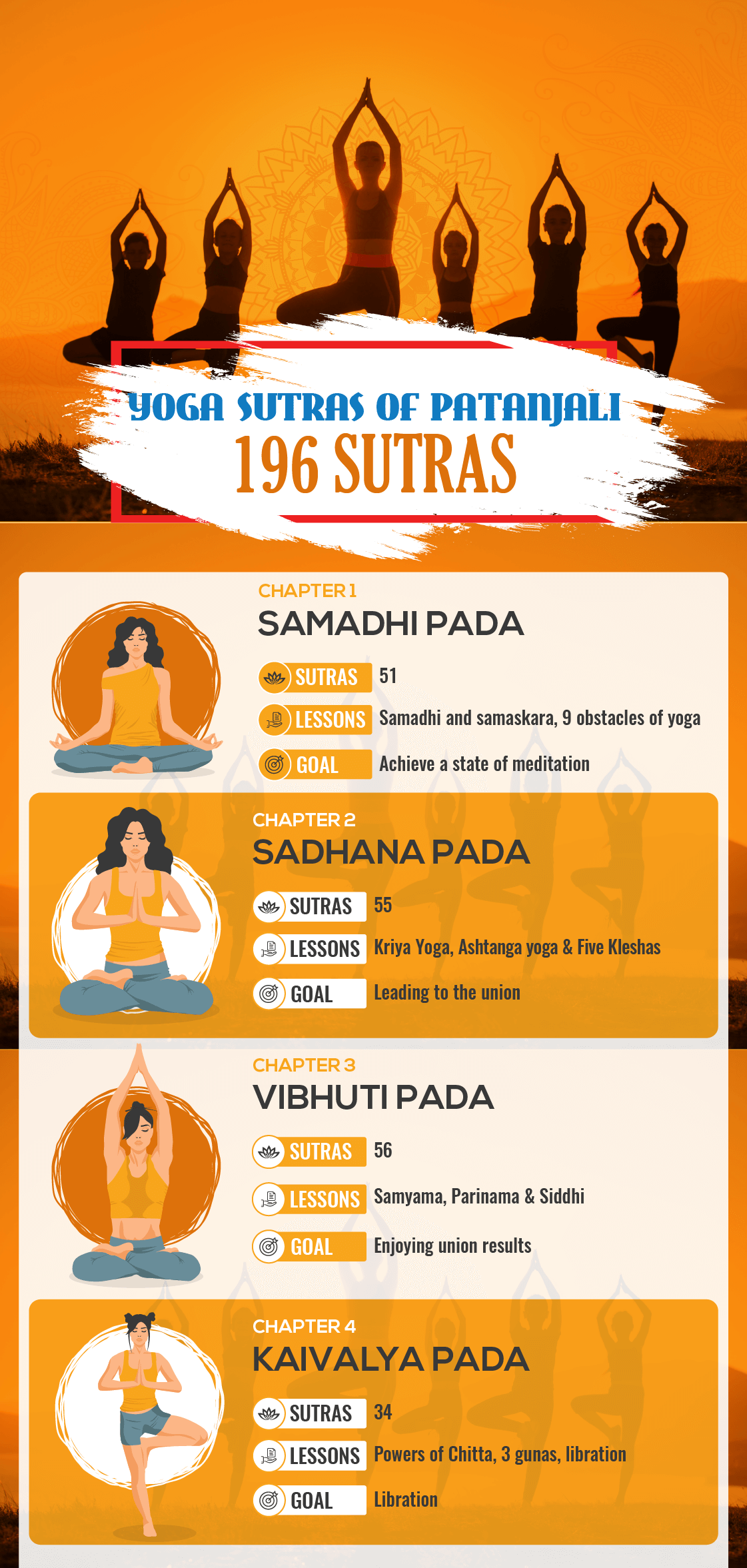
The Yoga Sutras of Patanjali are divided into 4 distinct chapters, referred to as Padas, every serving as a progressive information to understanding and mastering the observe of yoga. These 4 sections systematically define the philosophy, methods, challenges, and supreme purpose of yoga.
- Samadhi Pada – The Chapter on Focus and Enlightenment
- Sadhana Pada – The Chapter on Follow and Self-discipline
- Vibhuti Pada – The Chapter on Powers and Supernatural Talents
- Kaivalya Pada – The Chapter on Liberation and Closing Emancipation
1st Chapter: “Samadhi Pada” Explains What Yoga Is!
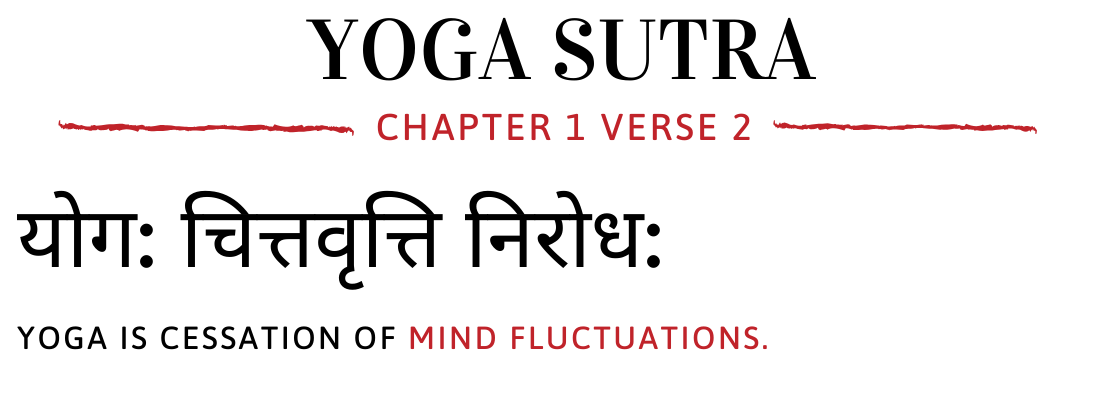
The primary chapter, Samadhi Pada, units the muse for understanding the true essence of yoga. It defines yoga because the cessation of the fluctuations of the thoughts (Chitta Vritti Nirodha) and elaborates on completely different sorts of Samadhi, or meditative absorption. This chapter is primarily aimed toward superior practitioners who’re already disciplined of their non secular path and search deeper meditative states.
Key factors in Samadhi Pada:
- Definition of yoga and its goal.
- Rationalization of Vrittis (psychological fluctuations) and methods to management them.
- Several types of Samadhi (Savitarka, Nirvitarka, Savichara, Nirvichara).
- Introduction of Ishvarapranidhana (give up to the divine) as a way to realize non secular liberation.
Breakdown of Sutras in Samadhi Pada:
- Sutras 1.1 to 1.4 – Outline Yoga because the cessation of psychological fluctuations (chitta vritti nirodha) and clarify the character of the seer (the self) when the thoughts is both purified or disturbed.
- Sutras 1.5 to 1.11 – Clarify the 5 sorts of psychological fluctuations (vrittis)—proper data, false impression, creativeness, deep sleep, and reminiscence—and the way yoga helps transcend them.
- Sutras 1.12 to 1.16 – Describe the twofold strategy to attaining psychological stillness: persistent observe and detachment (abhyasa and vairagya).
- Sutras 1.17 to 1.18 – Outline completely different ranges of Samadhi (meditative absorption) and the function of samskaras (impressions of previous karma) in influencing one’s non secular progress.
- Sutras 1.19 to 1.22 – Categorize several types of seekers and emphasize the roles of religion, dedication, and reminiscence in advancing on the yogic path.
- Sutras 1.23 to 1.29 – Spotlight the importance of Ishvara (the Supreme Being) and OM as its sacred image, emphasizing devotion (Ishvarapranidhana) as a way to liberation.
- Sutras 1.30 to 1.32 – Determine 9 obstacles that hinder progress in yoga, akin to doubt, laziness, and distractions.
- Sutras 1.33 to 1.39 – Present sensible strategies to beat these obstacles, together with cultivating constructive attitudes and specializing in breath or inside gentle.
- Sutras 1.40 to 1.51 – As soon as the thoughts is stabilized, these sutras information the seeker by completely different phases of Samadhi, in the end resulting in Kaivalya (absolute liberation).
2nd Chapter: “Sadhana Pada” Explains Steps to Union
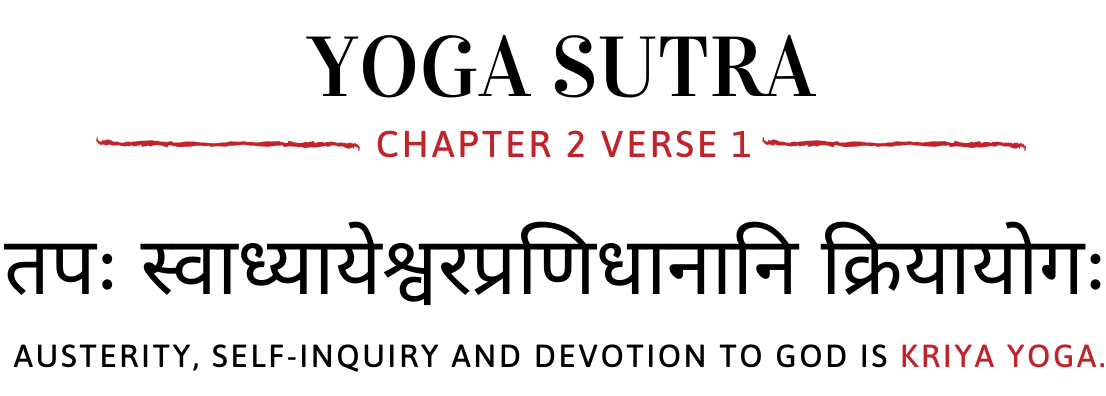
The second chapter, Sadhana Pada, focuses on the disciplined observe required to progress on the yogic path. It’s right here that Patanjali introduces the Ashtanga Yoga (Eightfold Path), which serves as a step-by-step information for attaining non secular evolution.
Key factors in Sadhana Pada:
- Introduction of Kriya Yoga (the yoga of motion): Tapas (self-discipline), Svadhyaya (self-study), and Ishvarapranidhana (devotion).
- Rationalization of the causes of struggling (Kleshas) and methods to overcome them.
- Detailed breakdown of the Eight Limbs of Yoga (Ashtanga Yoga):
Breakdown of Sutras in Sadhana Pada
- Sutras 2.1 to 2.2 – Introduce Kriya Yoga (the yoga of motion), comprising:
- Tapas (austerity)
- Svadhyaya (self-study)
- Ishvara Pranidhana (give up to God)
These practices purify the thoughts and put together it for larger meditation.
- Sutras 2.3 to 2.9 – Focus on the 5 kleshas (afflictions) that trigger struggling:
- Avidya (ignorance)
- Asmita (egoism)
- Raga (attachment)
- Dvesha (aversion)
- Abhinivesha (clinging to life)
Understanding and addressing these afflictions is important for non secular progress.
- Sutras 2.10 to 2.11 – Clarify the consequences of those afflictions:
- They’re current in each refined and manifest varieties.
- They trigger struggling till eradicated.
Meditation is a key technique to beat them.
- Sutras 2.12 to 2.14 – Describe how the impressions of previous actions (samskaras) are rooted within the kleshas and affect future experiences. Eliminating these impressions results in liberation.
- Sutras 2.15 to 2.16 – Elaborate on the character of the kleshas and their impression on actions and reactions, perpetuating the cycle of struggling.
- Sutras 2.17 to 2.18 – Outline the character of samskaras (psychological impressions) and the way previous actions go away deep traces that have an effect on the thoughts.
- Sutras 2.19 to 2.21 – Focus on the significance of understanding the nature of thoughts and the function of meditative observe in reworking these psychological impressions.
- Sutras 2.22 to 2.26 – Current methods to purify the thoughts by self-discipline, detachment, and devotion, and the way the thoughts’s distractions may be eliminated by targeted meditation.
- Sutras 2.27 to 2.29 – Clarify the phases of observe and the progress {that a} yogi experiences as they transfer by these phases: from Dharana (focus) to Dhyana (meditation) to Samadhi (absorption).
- Sutras 2.30 to 2.32 – Describe the moral observances (Yamas and Niyamas) and the way they function the muse for private development and self-discipline.
- Sutras 2.33 to 2.35 – Present methods for overcoming distractions and obstacles by psychological coaching, deal with respiration, and cultivating a constructive angle.
- Sutras 2.36 to 2.39 – Clarify the qualities of a practitioner who has developed mastery in meditation, together with fearlessness, self-control, and the flexibility to withstand distractions.
- Sutras 2.40 to 2.45 – Focus on the significance of Pratyahara (withdrawal of the senses) and the way it permits deeper focus and in the end results in self-realization.
- Sutras 2.46 to 2.48 – Outline Asana (bodily postures) and the way they contribute to the observe of yoga by creating a gentle, comfy posture for meditation.
- Sutras 2.49 to 2.53 – Focus on Pranayama (management of breath) and its function in regulating the life power (prana), resulting in psychological readability and stability.
- Sutras 2.54 to 2.55 – Clarify Pratyahara (withdrawal of the senses) and the way it permits deeper focus and in the end results in self-realization.
third Chapter: “Vibhuti Pada” Explains Powers of Yoga
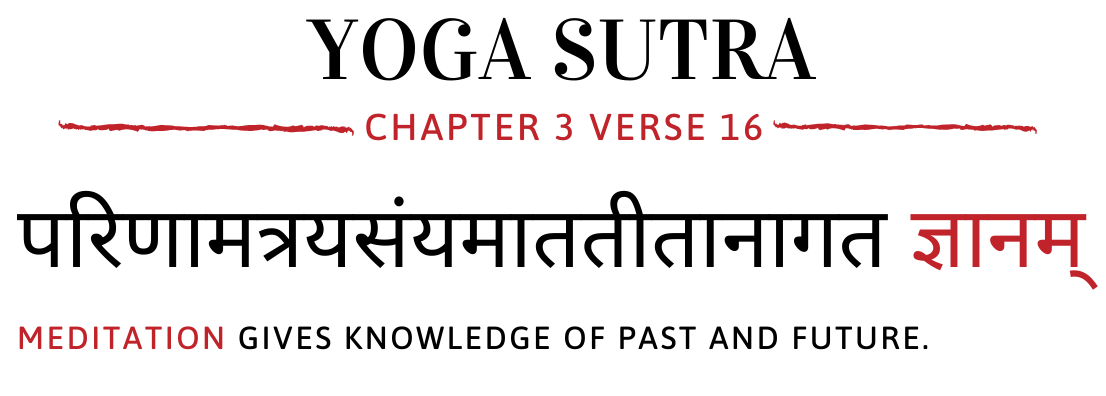
The third chapter, Vibhuti Pada, describes the extraordinary capabilities (Siddhis) that yogis could develop by devoted observe. These embrace heightened sensory notion, mind-reading, and even supernatural talents. Nevertheless, Patanjali warns that these powers, although fascinating, can change into distractions on the non secular path.
Key factors in Vibhuti Pada:
- Rationalization of Dharana (focus), Dhyana (meditation), and Samadhi (absorption) as a mixed observe referred to as Samyama.
- Description of assorted Siddhis (non secular powers) and the way they manifest.
- Warning in opposition to being connected to those powers, as they’ll hinder enlightenment.
This chapter serves as each an inspiration and a warning, guiding yogis to stay targeted on liberation relatively than getting misplaced in mystical talents.
Breakdown of Sutras in Vibhuti Pada
- Sutras 3.1 to three.3 – Introduce the ultimate three limbs of Ashtanga Yoga:
- Dharana (focus): Fixing the thoughts on a single level or object.
- Dhyana (meditation): Sustained focus, resulting in a circulation of consciousness.
- Samadhi (absorption): Full merging with the item of meditation.
These three collectively are referred to as Samyama, the gateway to unlocking deeper powers.
- Sutras 3.4 to three.9 – Clarify Samyama and its transformative energy
- Samyama: The mixed observe of Dharana, Dhyana, and Samadhi.
- Utility: When utilized to completely different objects or ideas, Samyama reveals hidden data and talents.
- Instance: Practising Samyama on the solar can reveal data of the photo voltaic system.
- Sutras 3.10 to three.16 – Focus on Parinama (transformation) and its sorts:
- Nirodha Parinama: Transformation by stillness (calming the thoughts).
- Samadhi Parinama: Transformation by meditative absorption.
- Ekagrata Parinama: Transformation by one-pointed focus.
These phases mark the yogi’s progress towards mastery.
- Sutras 3.17 to three.49 – Discover the Siddhis (supernatural powers):
- 3.17 to three.18: Understanding the connection between phrases, objects, and their deeper meanings.
- 3.19 to three.21: Gaining data of previous lives and others’ minds.
- 3.22 to three.24: Creating invisibility and extraordinary energy.
- 3.25 to three.29: Mastering parts like earth, water, hearth, air, and area.
- 3.30 to three.34: Reaching perfection of the physique and senses (e.g., immunity to starvation and thirst).
- 3.35 to three.39: Gaining management over pure forces and cosmic data.
- 3.40 to three.44: Mastering the senses and attaining lightness (e.g., levitation).
- 3.45 to three.49: Attaining perfection of the physique and thoughts, resulting in liberation.
- Sutras 3.50 to three.56 – Clarify Kaivalya (liberation):
- 3.50 to three.52: The yogi transcends attachment to even the best powers.
- 3.53 to three.55: Reaching Viveka Khyati (discriminative data) between the pure Self and the thoughts.
- 3.56: The ultimate stage of Kaivalya, the place the Self exists in its pure, liberated state, free from all afflictions and karma.
Key Takeaways from Vibhuti Pada
- Samyama: The important thing to unlocking deeper data and powers.
- Siddhis: Extraordinary talents that come up from superior observe however should not the final word purpose.
- Kaivalya: The true goal of yoga—liberation from all attachments and limitations.
4th Chapter: “Kaivalya Pada” Explains Idea of Liberation
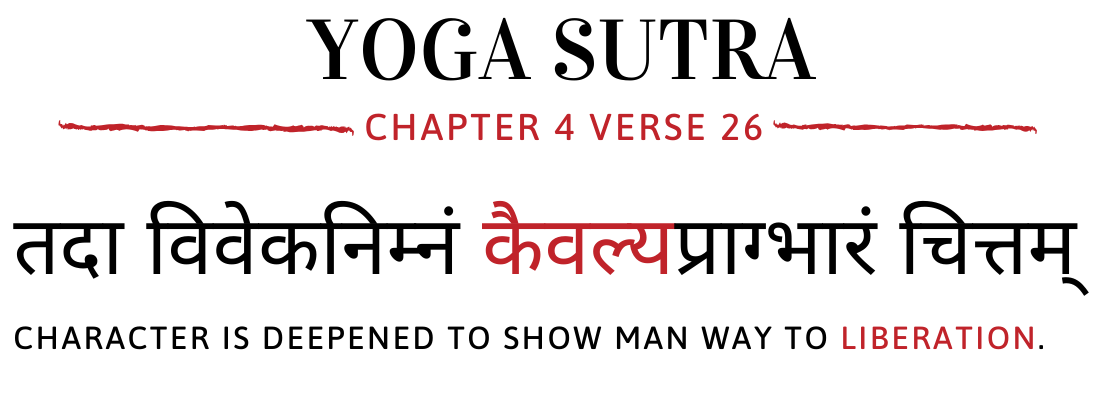
The ultimate chapter, Kaivalya Pada, describes the final word purpose of yoga—full liberation (Kaivalya), the place the practitioner transcends all worldly attachments and realizes their true nature as pure consciousness. This state is past all dualities and results in everlasting peace.
Key factors in Kaivalya Pada:
- How the thoughts dissolves, resulting in Kaivalya (liberation).
- The excellence between Purusha (pure consciousness) and Prakriti (nature/matter).
- Overcoming previous karmic influences to realize absolute freedom.
This chapter concludes the Yoga Sutras with the reassurance that by devoted observe and inside knowledge, enlightenment is achievable.
Breakdown of Sutras in Kaivalya Pada
- Sutras 4.1 to 4.3 – Attaining Siddhi (Religious Powers)
- 4.1: Siddhis (powers) may be gained by:
- Beginning (janma), herbs (aushadhi), mantras (mantra), austerity (tapas), or meditation (samadhi).
- 4.2-4.3: Transformation (parinama) is pushed by effort and divine grace.
- Key Thought: Religious progress requires each self-discipline and give up.
- 4.1: Siddhis (powers) may be gained by:
- Sutras 4.4 to 4.6 – The Energy of Chitta (Thoughts-Stuff)
- 4.4: Particular person consciousness (asmita, ego) creates distinct realities.
- 4.5-4.6: The thoughts’s exercise tasks a number of realities, however a yogi’s thoughts is unified and targeted.
- Instance: A relaxed thoughts sees reality; a distracted thoughts creates illusions.
- Sutras 4.7 to 4.8 – Karma and Its Results
- 4.7: Actions (karma) are impartial however coloured by wishes (kleshas).
- 4.8: Previous actions (samskaras) form future experiences.
- Takeaway: Liberation requires dissolving karmic imprints.
- Sutras 4.9 to 4.11 – The Function of Needs
- 4.9-4.10: Needs (vasanas) create continuity throughout lifetimes.
- 4.11: Needs are sustained by reminiscence and attachment.
- Answer: Detachment (vairagya) breaks the cycle.
- Sutras 4.12 to 4.14 – The Tri-Gunas (Three Qualities of Nature)
- 4.12: Actuality is ruled by three qualities:
- Sattva (purity), Rajas (exercise), Tamas (inertia).
- 4.13-4.14: The interaction of Gunas creates all experiences.
- Purpose: Transcend the Gunas to realize liberation.
- 4.12: Actuality is ruled by three qualities:
- Sutras 4.15 to 4.28 – Eradicating Obstacles to Liberation
- 4.15-4.17: The thoughts perceives objects in a different way based mostly on perspective.
- 4.18-4.21: The true Self (Purusha) is unchanging; solely the thoughts fluctuates.
- 4.22-4.24: Liberation comes when the thoughts displays the Self’s purity.
- 4.25-4.28: Follow (abhyasa) and discernment (viveka) dissolve ignorance (avidya).
- Sutras 4.29 to 4.33 – Phases of Liberation
- 4.29-4.30: Renouncing even the need for enlightenment results in dharma megha samadhi (cloud of advantage).
- 4.31-4.33: In liberation:
- Sutra 4.34 – The Closing State of Kaivalya
- 4.34: Kaivalya is absolute freedom:
- The Self (Purusha) exists in its pure essence, untouched by time, karma, or the thoughts.
- Metaphor: Like a lamp undisturbed by wind, the liberated Self stays regular.
- 4.34: Kaivalya is absolute freedom:
Key Takeaways from Kaivalya Pada
- Liberation is Past Powers: Siddhis are milestones, not the purpose.
- Transcend the Gunas: True freedom lies outdoors nature’s three qualities.
- Dissolve Karma: Detach from wishes and previous impressions (samskaras).
- The Self is Everlasting: Liberation is realizing you’re the unchanging witness.
Conclusive phrases
In conclusion, the Yoga Sutras of Patanjali provide a profound information to attaining self-realization and liberation by psychological self-discipline and non secular observe. By addressing the character of the thoughts, obstacles, and the trail of devotion, Patanjali gives a structured framework for private transformation.
Patanjali’s teachings on focus, meditation, and better states of consciousness lead practitioners towards inside peace and supreme freedom. The Yoga Sutras stay a timeless and invaluable useful resource for these searching for non secular development, providing clear insights into methods to transcend worldly distractions and join with the upper self.

